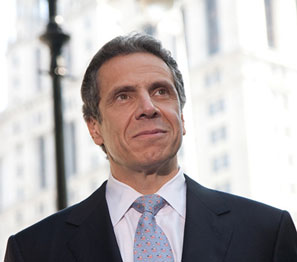
In the last eight months, New York governor Andrew Cuomo has proposed two major economic and tax initiatives that have spurred intense opposition from factions on the left. Last June, liberal advocacy groups in Albany protested the governor’s START-UP NY plan, since passed into law, to create tax-free zones for new businesses throughout the state. Now public-sector unions are sponsoring an ad campaign criticizing the governor’s recently proposed package of tax cuts as “another special giveaway” to businesses and the wealthy. For a politician who has described himself as a progressive, the verbal assaults on Cuomo from his left might seem baffling.
But it’s an election year in New York, and Cuomo faces no serious left-wing challenger. He will square off instead with a Republican, probably the successful Westchester County Executive, Rob Astorino, who has won two impressive victories in a largely Democratic county. Astorino has been especially effective making the case that New York’s property taxes are too high, and that he has effectively controlled them during his tenure. Not coincidentally, Cuomo’s emphasis on tax-free zones and tax cuts appeal to two constituencies that Astorino hopes to reach: upstate New Yorkers living in economically depressed areas and downstate Republican business executives who might cross over and donate to Democrats in this campaign. In an election year, it can be difficult to separate an incumbent’s politics from his policy.
Cuomo is hoping his heavily advertised tax-free zones will send the message to upstate residents, who are more conservative than those living around the Greater New York City area, that he’s trying to boost job growth in their region. But he faces skepticism from critics across the ideological spectrum who see programs like this as generally ineffective. For years, because of its high tax rates, New York has cut special deals with companies—to bring them here, keep them here, or help them expand. Cuomo’s plan puts a minor new spin on that tradition, creating enterprise zones around colleges and universities in which new or expanding firms would be free from paying all taxes for 10 years. But the plan is limited geographically and applies only to firms in certain industries. And while the governor says that it won’t cost anything, the risk of the program and others like it is that the state won’t see any real economic boost from companies that might have been ready to start or expand anyway. Now they can do so for free.
Cuomo and state government agencies have also been aggressively promoting the program nationally, hoping to attract firms to New York. Will it work? Well, consider: New York already spends about $7 billion annually on state and local tax breaks for businesses and other forms of economic “investment,” with virtually no payoff, in a state where job growth has lagged the nation for decades. “Most of the $7 billion now spent annually in New York on economic development lacks adequate controls or data to prove the investments are worthwhile,” the Citizens Budget Commission, a fiscal watchdog group, observed last year. The governor’s own tax-reform commission noted that the state’s $420 million in film and television production-tax credits, one of the largest tax-incentive programs, “does not appear to pay for itself.”
That huge pot of money represents a true opportunity for a committed tax-cutter. Earlier this year, the governor proposed a $2 billion tax cut to spur economic growth. It includes about $350 million annually in corporate tax cuts, a generous reduction in the state’s high estate tax—which, when fully phased in, will cost about $750 million annually—and more than $1 billion in tax credits for homeowners and renters. While those cuts are significant, they’re not even enough to offset completely the tax increases New York instituted to close budget gaps in recent years. A truly bold idea, by contrast, would be to wind down the state’s expensive regime of ineffective, targeted tax credits for favored industries and other investments and simply apply that money to lower tax rates for all businesses and residents. The state and its localities spend about $3.5 billion on tax credits alone for businesses; agencies invest another $3 billion on development projects designed to create jobs. Those are two enormous pots of money that, when put toward tax cuts, could make a real dent in the state’s tax burden, currently considered the nation’s highest by the nonpartisan Tax Foundation.
Business executives and conservatives might be justifiably skeptical about the governor’s election-year conservative tilt and wonder whether, if reelected, Cuomo will follow through. To pay for tax cuts already on the books, Cuomo has pledged to hold spending growth to 2 percent annually. Given his ambitious education-spending agenda, that will require keeping the rest of the budget virtually flat for several years. Cuomo has done a better job than any governor since Hugh Carey in holding down the state legislature’s spending excesses, but he’ll have his hands full duplicating that feat for four more years.
Still, it’s a good sign when the Democratic governor of one of the country’s largest and highest-taxed states is vigorously making the case for rolling back rates. “New York has no future as the highest-taxed state in the country,” Cuomo likes to say. Overburdened New Yorkers shouldn’t let him forget it.